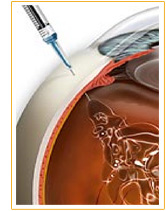Intravitreal Injection
Intravitreal Injection

It is becoming increasingly popular to deliver medications to the retina by direct injection into the vitreouscavity. Delivery of medications into this area offers several advantages.
The retina, which is the target tissue, is directly in contact with the vitreous cavity. This allows for rapid delivery of a drug to its target using as low an effective dose as possible. Direct delivery of drug in front of the retina may reduce or eliminate side effects to the rest of the body; this is due to the lower dose used as well as the general low absorption into the bloodstream from the eye.
Many patients are hesitant about the prospect of receiving a needle into their eye. The procedure sounds much worse than it actually is. The actual injection takes only a few seconds and is described as painless or minimally uncomfortable in a great majority of cases.

The injection procedure starts with an anesthetic eyedrop to numb the surface of the eye. Sometimes, a small amount of anesthetic is injected at the site using a tiny needle. The eye is then prepared with an antiseptic solution (usually containing iodine) to help sterilize the ocular surface and reduce the risk of infection. The medicine is injected very gradually and carefully over a few seconds, and the needle is then withdrawn. The eye pressure must be checked after a few minutes following injection. There is sometimes mild redness at the injection site. There is occasional tenderness, but most patients do not report any pain. Sometimes, an antibiotic eyedrop is prescribed for several days to help prevent infection.
The intravitreal injection procedure is generally safe and effective. The specific details depend on the disease being treated and the drug being injected; these issues will be discussed with you in detail by your retina doctor. Certain low risks are associated with all injections and include the following: infection, bleeding, cataract and intraocular pressure rise.
Injections into the eye are more commonly being used in the treatment of: wet age-related macular degeneration, diabetic retinopathy, retinal vein occlusions, macular edema, and endophthalmitis (serious eye infection).
Certain drugs are approved for use inside the eye, and even more are being researched in experimental trials.
Last Updated: October 23, 2024














